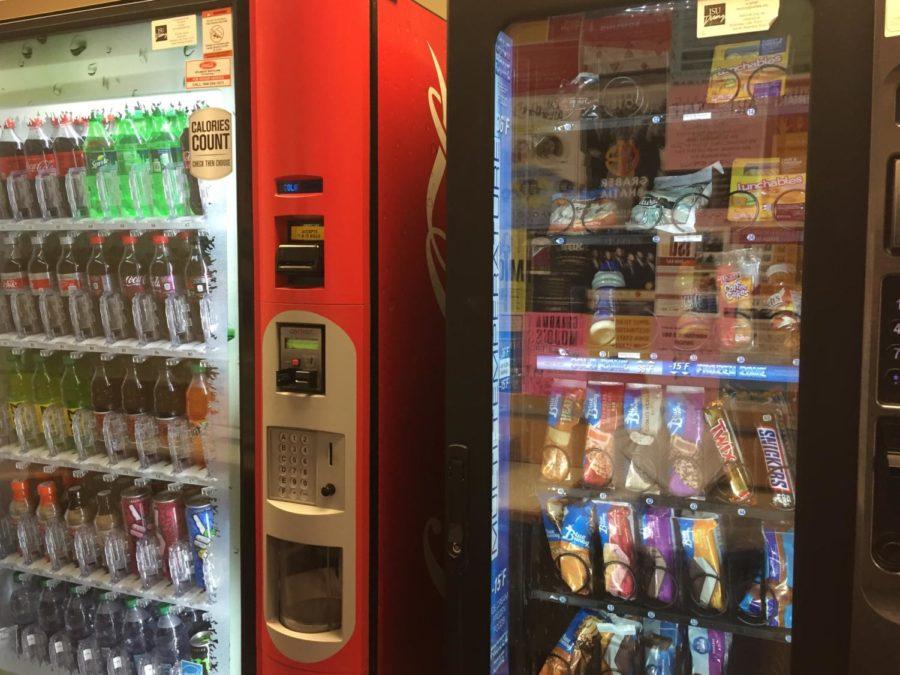Iowa State offers several resources for student nutrition
McKenzie Reimer/Iowa State Daily
Vending machines at Iowa State University.
February 21, 2019
Iowa State University offers places to eat in a variety of campus locations, with an abundance of options for students and faculty members.
According to the Iowa State University Dining webpage, there are 24 dining centers and 160 Coca-Cola machines on campus, along with 90 vending machines, featuring a variety of foods and drinks.
Biology major Shelby Benoit said she grabs a meal on campus at least once a day.
“I usually get a sandwich at the [Bookends] Cafe or sometimes I’ll go to the Dining Center if it’s close,” Benoit said.
The ISU Dining webpage offers an in-depth look at the nutritional information of the food served in each of the dining centers menus. It provides students with information on total calories, total fat and sodium content as well as vegetarian and vegan options.
Kallen Anderson, the registered dietitian for ISU Dining, provides nutrition counseling and medical nutrition therapy to students who have a meal plan with ISU Dining.
Anderson said students will reach out to her when they don’t know how to find nutrition information on specific menu items. For students who do not have meal plans, they can reach out to Lisa Nolting, the Registered Dietitian with Student Wellness.
Anderson said when it comes to nutritional needs, students should be looking at creating a balanced plate.
“No need for ‘diet plans’ or restricted eating – diets don’t work anyway. Learning how to create balanced plates and having half of the plate be fruits and vegetables are important skills to learn now in college and beyond,” Anderson said.
Benoit said when she is not on campus she is usually eating food from Hy-Vee or from a fast food restaurant.
“I guess because it’s cheap and it’s quick,” she said. “I’ve definitely been meaning to eat better but it’s hard,” Benoit said.
While there are a lot of resources on campus for finding quick meals, there are options available outside of Iowa State University for students who cannot always afford to eat on campus or want different or healthier options.
One available resource for students is “Spend Smart. Eat Smart.” This program was created during the 2008 recession to help get information about food resources out to struggling families or people with food insecurity.
Since then, “Spend Smart. Eat Smart.” evolved to help Iowans plan out meals and budget ahead of time by using templates, tips, links and nutritional information. They also offer a variety of recipes to make it easier for people to shop on a budget.
Christine Hradek, the program coordinator for “Spend Smart. Eat Smart.”, said since it re-launched in 2017, there have been 8,000 downloads for their smartphone app, and 10,000 users per month on their website.
“The most common thing people tell us in terms of healthy changes they’ve made from the website are that they are trying new recipes and eating more fruits and vegetables,” Hradek said. “All of the recipes on ‘Spend Smart. Eat Smart.’ are all analyzed for nutritional content to meet certain standards.”
Besides looking at “Spend Smart. Eat Smart.”, both Hradek and Anderson have recommended reaching out to the dietitians on campus and creating a balanced diet.
Anderson also recommended looking at The Academy of Nutrition and Dietetics website. It offers articles on topics related to eating better and healthier.
“We would encourage students to be really savvy consumers when they think about where they are getting their nutrition advice,” Hradek said. “There is a lot of information online from bloggers and people that kind of claim to know a lot about nutrition, but a lot of what they share is not science-based and is more about selling something or maybe following a trend.”







